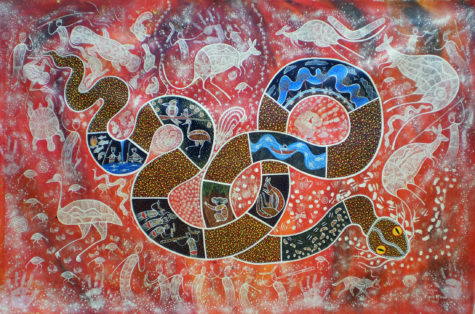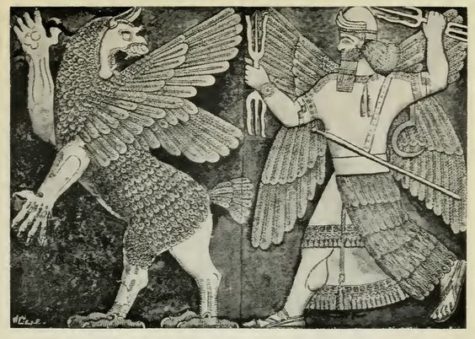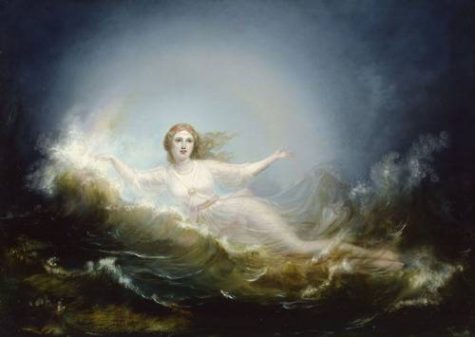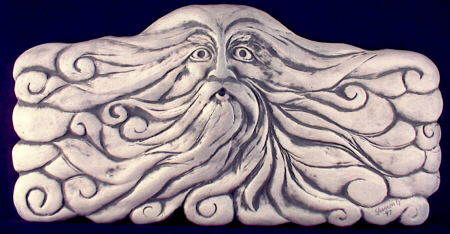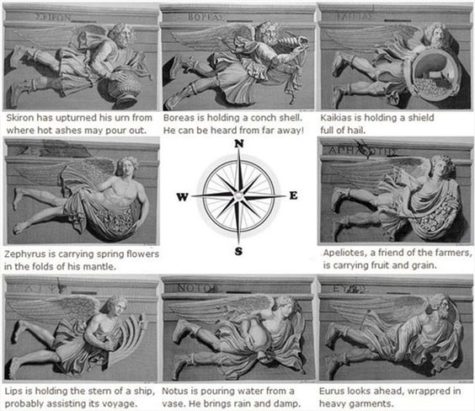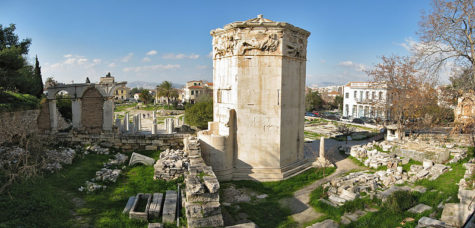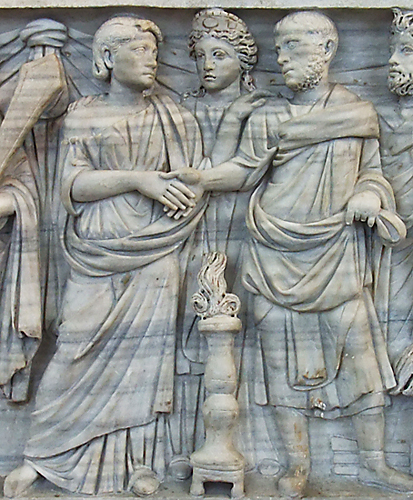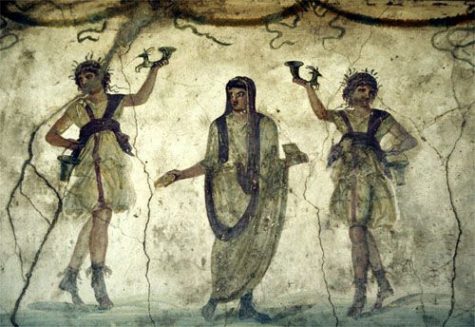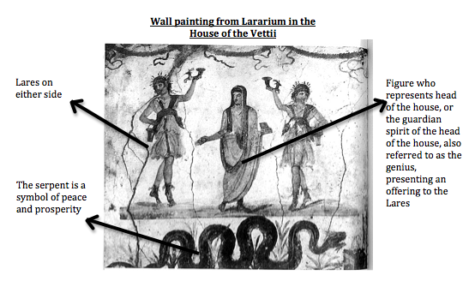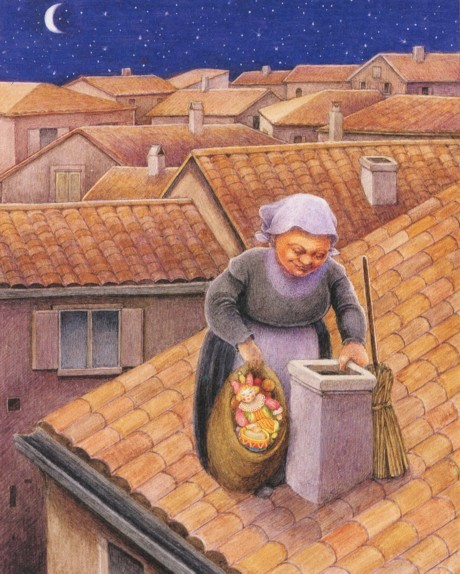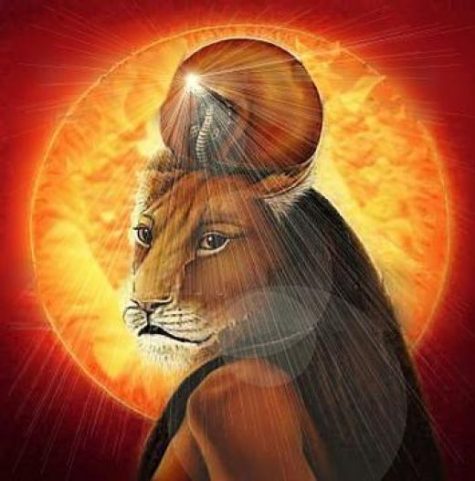Yearly Archives: 2017
- Other names: Damballah Weddo, Da, Papa Damballa, Obatala
- Manifestation: Damballah is a huge snake, so big his body forms seven thousand coils
- Color: White
- Day: Thursday
- Plants: Bougainvillea, trees in general, but especially the silk cotton tree (Bombax ceiba) and the Royal palm.
- Altar: Keep shallow vessels of clean, fresh water for him to curl up inside.
- Holiday: March 17 (St. Patrick’s Day)
Once upon a time, there was only Damballah. He lay beneath Earth, a great snake, cushioning and protecting it from falling into the watery abyss below. Although he lay still for a long time, eventually he had to move. His movements raised mountains and created valleys. Stars were shaken up into the sky. Sacred waters were released, forming oceans, rivers, springs and streams.
The first rain began to fall, and Aido-Hwedo, in the guise of the first rainbow, appeared. Damballah and Aido-Hwedo fell in love. They remain in love today. The intensive all pervasive power of that love infiltrated the entire universe. That power is manifest in human beings in the form of white liquids: milk and semen.
Associated Catholic Saint Patrick (who drove the snakes out of Ireland), and sometimes also Moses, whose staff transformed into a snake to prove the power of God over that wielded by Egyptian priests, Damballah is the primordial snake Iwa of life, wealth and wisdom. He is venerated in Dahomey as well as Haitian Vodou. He may also survive in the New Orleans folk saint Blanc Dani.
Damballah is among the most beloved and important Iwa. He associated with creation and is viewed as a loving father to the world. His presence brings peace and harmony. He bestows wealth, prosperity, good health, and fertility to devotees and can expose the location of missing treasure.
Damballah and his true love, the rainbow serpent, maintain the balance of forces, which sustains all ife on Earth. As a source of life, he is also strongly associated with water and regulates moisture and the rain.
He is incredibly old and powerful and is usually not bothered for trivial matters. He can be extremely generous, however, and so may be approached when one is genuinely desperate or really in trouble. Despite his venerable age, he remains interested in people. He will engage in sacred marriages with women but also occasionally with men.
Dambullah appears in dreams. He does not communicate well. You must pay attention. He is so old and primal that he is pre-articulate; he emerges from a time before speech. Damballah may hiss or make whistling noises but does not speak human language.
When he possesses a human, he does not speak but instead only hisses and whistles. His movements are also snake-like, and can including slithering along the ground, flicking his tongue, and climbing tall objects.
He is a stickler for cleanliness. He doesn’t like strong, pervasive odors of any kind, but especially tobacco. If you smoke, then do so far from his altar space or anywhere associated with him. He may object to cleaning products with strong odors too, as well as air fresheners with strong aromas. Rooms should smell clean and fresh. Open a window to aerate them. He does not object to light floral odors, like rose or orange blossom water, and traditionally expresses a fondness for Pompeii Lotion, a cologne product found in botanicas and spiritual supply stores.
Offerings:
For a very traditional offering, make a bed or hill of white flour on a perfectly clean, pure white plate. Nestle one whole, raw white egg into the center of the flour and serve.
Other offerings could include white candles and white foods like rice, milk, whole raw eggs (leave them plain or rub gently with rose or other mildly scented, fine quality floral water), corn syrup, white chickens, or white flowers. More lavish offerings might include luxurious white fabrics, crystal or porcelain eggs and/or snakes.
Veve for Damballa and Ayida-Weddo:
From; Encyclopedia of Spirits
When Babylon became the capital of Mesopotamia, Marduk, the patron deity of Babylon was elevated to the level of supreme god. Acknowledged as the creator of the universe and of humankind, the god of light and life, and the ruler of destinies, he rose to such eminence that he claimed 50 titles. His name literally means “bull calf of the sun”.
In order to explain how Marduk seized power, the Enûma Elish was written, which tells the story of Marduk’s birth, heroic deeds and becoming the ruler of the gods. Also included in this document are the fifty names of Marduk.
According to this ancient epic poem of creation, Marduk defeated Tiamat and Kingu, the dragons of chaos, and thereby gained supreme power.
The story is as follows:
A civil war between the gods was growing to a climactic battle. The call went out to find one god who could defeat the opposing Gods and the Dragons of Chaos rising against them. Marduk, a very young god, answered the call and was promised the position of head god if he could get the job done.
To prepare for battle, he makes a bow, fletches arrows, grabs a mace, throws lightning before him, fills his body with flame, makes a net to encircle Tiamat (the dragon) within it, gathers the four winds so that no part of her could escape, creates seven nasty new winds such as the whirlwind and tornado, and raises up his mightiest weapon, the rain-flood. Then he sets out for battle, mounting his storm-chariot drawn by four horses with poison in their mouths. In his lips he holds a spell and in one hand he grasps a herb to counter poison.
First, he challenges the leader of the Anunnaki gods, the dragon of the primordial sea Tiamat, to single combat and defeats her by trapping her with his net, blowing her up with his winds, and piercing her belly with an arrow.
Then, he proceeds to defeat Kingu, the god in charge of the army and who also wore the Tablets of Destiny on his breast. Marduk “wrested from him the Tablets of Destiny, wrongfully his” and assumed his new position. Under his reign humans were created to bear the burdens of life so the gods could be at leisure.
Marduk was depicted as a human, often with his symbol the snake-dragon which he had taken over from the god Tishpak. Another symbol that stood for Marduk was the spade.
Another take on the story:
In ancient Mesopotamia, the final days of the year were a time of decay and death, as the very year itself withered and died, and thoughts turned to the departed. The terrible chaos goddess Tiamat threatened to destroy the world and all its inhabitants; she was a sea-monster, born of the marriage of fresh and salt water, who gave birth to a generation of young gods, on whom she later declared war. From these young gods, one rose to lead the fight against Tiamat and defeated her, thus saving the world.
Marduk’s Names:
He was Marduk, a young Sun god, whose name comes through amar-ud – ‘Youth of the Sun’, and maru Duku – ‘Child of the Holy chamber’, who was also called Bêl which means ‘Lord’ and may be known to Bible readers as Ba’al (when Bêl is mentioned, it always refers to Marduk). He rose to such eminence that he claimed 50 titles. His name literally means “bull calf of the sun”.
The Fifty Names of Marduk as recounted in the Enûma Elish, and can be found here: The Fifty Names of Marduk.
Attributes and Powers:
Marduk fought against chaos and was killed, spending time in the underworld before being resurrected, returning to life to defeat the forces of evil and so becoming the King of the gods.
He was a fertility god and a grain god, his death symbolized the death of the sun in winter, his sojourn in the underworld is the grain lying dormant in the ground, and his return is the arrival of spring, new growth and green leaves.
Marduk was depicted as a human, often with his symbol the snake-dragon which he had taken over from the god Tishpak. Another symbol that stood for Marduk was the spade.
According to the mythology of the Necromonicon, (a work of fiction by H P Lovecraft), and an adaptation of that mythology, The Necronomicon Spellbook, Marduk was the God who defeated the Ancient Ones long before the creation of matter as we know it. The Fifty Names, (according to the Necronomicon) were titles given to Marduk by the Elder Gods after he had helped them to defeat the Ancient Ones. These names were assigned Sigils and Words of Power, you can read more about them here: About The Fifty Names of Marduk
- Titles: Daughter of Nature, Goddess of Creation, Water Mother, Sky Mother
- Other Names: Luonnotar, Luonotar
- Origin: Finland
- Depicted as: Virgin floating on the sea
- Feast day: August 26
The name Ilmatar is derived from the Finnish word ilma, meaning “air,” and the suffix -tar, denoting a female spirit. Thus, her name literally means “female air spirit.” In the Kalevala she was also occasionally called Luonnotar,which means “female spirit of nature” (Finnish luonto, “nature”)
The story is as follows:
In the beginning, says the Kalevala, there was only Ilmatar, the void and a great deal of wind. She was alone in the beginning of time. She lived in the heavens, but eventually she grew restless and slipped into the vast cosmic sea. She floated and frolicked for centuries on this primordial ocean, counting rainbows and letting the wind play in her hair.
She began to long for a son.Her longing was so great that the East Wind itself took pity. She found herself buffeted and tossed by the wind’s tempestuous love-making until, exhausted, she could bear it no longer and collapsed. During this storm she became pregnant. And there, inside her, was conceived Vainamoinen, the child of the wind.
The goddess floated for centuries on this primordial ocean, unable to give birth because there was no land. She prayed constantly to the god Ukko, the highest of the gods, to help her. After seven centuries or so she began to give up hope, and Ukko took pity on her and sent a duck.
The poor bird was desperately looking for somewhere to land so she could make a nest and lay her eggs. When Ilmatar saw the bird’s predicament, she helpfully raised her knee and the bird came swooping down. Half a dozen cosmic eggs were laid, followed by an egg made of iron. The bird then gathered them all up, sat upon them and went to sleep.
Luonnotar sat and watched the bird eagerly, happy for something to finally be happening after centuries of loneliness and boredom. She became too excited, however, her leg began to heat up, she became extremely uncomfortable. Slowly, carefully, she began to stretch out her leg.. and slowly, inevitably, the seven eggs rolled off and fell majestically into the raging sea.
Now, cosmic eggs are delicate things, as soon as they fell into the waters, they broke open. Ilmatar watched in amazement as the broken shells of the eggs formed the heavens and the earth. The yolks became the sun, the whites the moon, and scattered fragments of the eggs transformed into the stars.
And thus the world was formed. As for the iron egg, the black yolk became a thundercloud.
Ilmatar was delighted with events, and busied herself shaping the lands and adding finishing touches. Even though dry land was now available, Ilmatar continued to carry the child within her for thirty summers while she finished her work. Eventually, she felt a stirring inside her. Vainamoinen had woken up after 30 years of being in the womb and was eager to see the new world. He had quite a struggle to get out, but he managed in the end and eventually, Ilmatar gave birth to Vainamoinen, a bouncing bonny old man, and the worlds first shaman, who then finished her creation.
Compiled from various sources
In ancient Roman mythology, Salacia was the female divinity of the sea, worshiped as the goddess of salt water who presided over the depths of the ocean. She was the wife and queen of Neptune, god of the sea and water.
You can petition Salacia for safety on the sea, prosperity, abundance, and true love. She has powers of healing and fertility and access to all the treasures of the sea.
Her story is as follows:
The god Neptune wanted to marry Salacia, but she was in great awe of her distinguished suitor, and to preserve her virginity, with grace and celerity she managed to glide out of his sight, and hid from him in the Atlantic Ocean. The grieving Neptune sent a dolphin to look for her and persuade the fair nymph to come back and share his throne. Salacia agreed to marry Neptune and the King of the Deep was so overjoyed at these good tidings that the dolphin was awarded a place in the heavens, where he now forms a well known constellation Delphinus.
Salacia is represented as a beautiful nymph, crowned with seaweed, either enthroned beside Neptune or driving with him in a pearl shell chariot drawn by dolphins, sea-horses (hippocamps) or other fabulous creatures of the deep, and attended by Tritons and Nereids. She is dressed in queenly robes and has nets in her hair.
Salacia was the personification of the calm and sunlit aspect of the sea. Derived from Latin sal, meaning “salt”, the name Salacia denotes the wide, open sea, and is sometimes literally translated to mean sensational.
As his wife, Salacia bore Neptune three children, the most celebrated being Triton, whose body was half man and half fish.
Other names and titles:
Salacia Neptuni which means “effervescence of Neptune”.She was sometimes invoked by Roman priests as “maia Volcani, Salacia Neptuni, hora Quirini, nerio Martis.” As Salachia, she is also sometimes known as the goddess of springs, ruling over the springs of highly mineralized waters. She is identified with the Greek goddess, Amphitrite, wife of Poseidon who shares a similar mythology.
From: Wikipedia and other sources
Note: This post was put together by Shirley Twofeathers, you may repost and share it only if you give me credit and a link back to this website. Blessed be.
- Origin: Greece
- Festival Days: Jan 16 and 17 – Greek festival in which offerings were made to the Wind Gods of the Eight Directions
In ancient Greek religion and myth, the Anemoi (Greek: Ἄνεμοι, “Winds”) were wind gods who were each ascribed a cardinal direction from which their respective winds came, and were each associated with various seasons and weather conditions.
They were sometimes represented as mere gusts of wind, at other times were personified as winged men, and at still other times were depicted as horses kept in the stables of the storm god Aeolus, who provided Odysseus with the Anemoi in the Odyssey. The Spartans were reported to sacrifice a horse to the winds on Mount Taygetus. Astraeus, the astrological deity, and Eos/Aurora, the goddess of the dawn, were the parents of the Anemoi, according to the Greek poet Hesiod. The daughters of the Anemoi are the Aurae (wind nymphs).
According to Hesiod, the beneficial winds, Notus, Boreas, Argestes, and Zephyrus, were the sons of Astraeus and Eos, and the destructive ones, as Typhon, are said to be the sons of Typhoeus. Later, especially philosophical writers, endeavoured to define the winds more accurately, according to their places in the compass.
The Anemoi are divided into two groups:
- Anemoi Major
- Boreas: North Wind
- Eurus: East Wind
- Notus: South Wind
- Zephyr: West Wind
- Anemoi Minor
- Apeliotes: Southeast Wind
- Kaikias: Northeast Wind
- Livos (Lips): Southwest Wind
- Skiron (Skeiron): Northwest Wind
Of the four chief Anemoi, Boreas (Aquilo in Latin) was the north wind and bringer of cold winter air, Zephyrus (Favonius in Latin) was the west wind and bringer of light spring and early summer breezes, and Notos (Auster in Latin) was the south wind and bringer of the storms of late summer and autumn; Eurus, the southeast (or according to some, the east) wind, was not associated with any of the three Greek seasons, and is the only one of these four Anemoi not mentioned in Hesiod’s Theogony or in the Orphic Hymns.
Other Minor Wind Deities:
- Argestes “clearing”, a wind blowing from about the same direction as Skiron (Caurus), and probably another name for it
- Aparctias, sometimes called the north wind instead of Boreas
- Thrascias, the north-north-west wind (sometimes called in Latin Circius)
- Euronotus, the wind blowing from the direction, as its name suggests, between Euros and Notos, that is, a south-southeast wind (Euroauster to the Romans)
- Iapyx, the northwest wind about the same as Caurus. It was this wind, according to Virgil, that carried the fleeing Cleopatra home to Egypt after she was defeated at the battle of Actium.
- Libonotus, the south-southwest wind, known as Austro-Africus to the Romans
- Meses, another name for the north-west wind Skiron
- Olympias, apparently identified with Skiron/Argestes
- Phoenicias, another name for the southeast wind (“the one blowing from Phoenicia”, due to this land lying to the south-east of Greece)
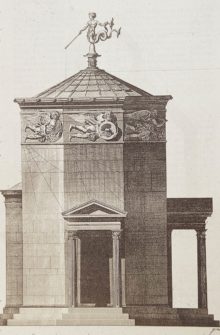 The most remarkable monument representing the winds is the octagonal tower of Andronicus Cyrrhestes at Athens. Each of the eight sides of the monument represents one of the eight principal winds in a flying attitude.
The most remarkable monument representing the winds is the octagonal tower of Andronicus Cyrrhestes at Athens. Each of the eight sides of the monument represents one of the eight principal winds in a flying attitude.
A moveable Triton in the centre of the cupola pointed with his staff to the wind blowing at the time.
All these eight figures have wings at their shoulders, all are clothed, and the peculiarities of the winds are indicated by their bodies and various attributes.
This is how it looks today:
- Origin: Rome
- Meanings: With-the-Heart, Agreement, Synthesis of Minds
- Sacred To Her: Olive branch; Grass; Wandering Jew; Salt (as in ‘salt of the earth’); Museums.
- Animal: Stork, Dove
- Other Symbols: Cornucopia, Caduceus, Star (emblem of hope), Two clasped hands (handshake)
- Feast Days: Jan 16, Feb 22, July 22, Aug 22,
- Associated with: Pax, Salus, Securitas, Fortuna. She was also paired with Hercules and Mercury.
- Greek Personification: Goddess Homonoia, the Greek personification of harmony.
Iconography: Concordia is portrayed sitting or standing, wearing a long cloak and holding a sacrificial bowl or an olive branch in her left hand and a cornucopia in her right symbolizing the prosperity that comes with peace.. Sometimes she can be seen standing between two members of the Royal House who clasp hands.
About Concordia:
Concordia is the Roman Goddess of agreement and harmony. The sister of peaceful Pax, she’s very conciliatory and will do almost anything to avoid upsetting people.
She was also responsible for harmony in marriage, as revealed by her epithet Concordia Conjugalis. Other epithets include Concordia Augusta (harmony of the emperor), Concordia Militaris (harmony of the army), and Concordia Provinciarum (harmony of the provinces).
Concordia is one of the oldest of the Roman deities, having been worshipped since the earliest days of Rome. She was worshipped in many temples, but the oldest was on the Forum Romanum and dates back to 367 BCE and was built by Camilus. The temple also served as a meeting-place for the Roman senate. she had another temple nearby on the Capitoline Hill.
In ancient Roman religion, Concordia is the goddess who embodies agreement in marriage and society. Her Greek equivalent is usually regarded as Harmonia, with musical harmony a metaphor for an ideal of social concord or entente in the political discourse of the Republican era. She was thus often associated with Pax (“Peace”) in representing a stable society. As such, she is more closely related to the Greek concept of homonoia (likemindedness), which was also represented by a goddess.
Unlike many other Goddesses who were deified qualities, Concordia was worshiped from early times in Rome. She especially symbolized peace and agreement between the two classes of Rome, the plebeians or commoners, and the patricians or nobles.
Concordia had a place in the festival of the Caristia or Charistia (meaning “Pardoning”) of February 22nd, a holiday celebrated by families in which it was traditional to reconcile differences and to mend quarrels or feuds within the family. Concordia was invoked for Her powers of bringing harmony and agreement, and other Deities invoked at the Caristia were Janus, the double-faced God of New Beginnings, Salus, the Goddess of Health, and Pax, Goddess of Peace.
These four Divinities were honored with statues grouped together at the Altar of Peace (not the great big famous one built by Augustus, but a smaller one whose location is unknown). They were also said to be worshiped together on the 30th of March and the 30th of January, and Concordia was invoked by matrons on April 1st at the Veneralia, the festival of Venus Verticordia, along with Fortuna and Venus Herself.
In the later days of the Empire, Concordia was worshiped as the bringer of marital harmony within the imperial family, and as such was called Concordia Augusta.
She was depicted as a matronly woman, veiled and heavily draped, holding an olive branch, emblematic of peace, and a cornucopia, to symbolize the abundance that can be achieved when people work together in harmony. She sometimes wore a crown and held a sceptre, caduceus, or patera, a small offering bowl from which libations were poured.
She is associated with the stork, which symbolized family devotion to the Romans, and the dove, universally a symbol of peace and gentleness; and sometimes a star, as emblem of hope, is shown near Her. Another attribute of Concordia is the image of two clasped hands, both of which are right hands (like in a handshake), symbolizing two people agreeing. She is often shown on coins commemorating joint rule of leaders or the marriages of the imperial family.
Inscriptions on coins refer to different applications of Concordia; these were probably not epithets, but rather illustrations of types of harmony, but I list some of them here: Concordia Militaris, “the Harmony of Armies”, Concordia Provinciarum, “the Harmony of the Provinces”, Concordia Conjugalis, “Harmony of Marriage”.
Here is some history:
In the early days of Rome the two classes had joined to drive out the tyrannical Kings and created a Republic; but it quickly became a Republic of the patricians who had all the wealth and power. The plebeians were barred from the Senate and other governmental and priestly offices, though they of course made up most of the army. In 494 BCE the plebeians had had enough, and, refusing to serve in the army anymore, deserted and camped out on a hill near the Anio River that they called the Mons Sacer, or the Sacred Mountain. The patricians, left defenseless, came to some kind of sense and reforms were instituted giving the plebeians more rights.
To commemorate the compromises worked out between patricians and plebeians, a temple to Concordia was built in the northwestern end of the Roman Forum, backed up against the Capitoline Hill, near the Volcanal, a raised area that housed an altar to Vulcan. This temple was originally vowed in 367 BCE by the general Camillus and dedicated on July 22nd (which became Her festival) sometime afterwards. This temple was of somewhat unusual proportions due to the constraints of the site, but it was accorded one of the most beautiful in Rome, as it was finely made and entirely faced in marble. In later times it served as a museum of sorts, and many famous works of art were housed there.
Notes:
- More about her feast days: Pagan Calendar
- More information can be found at Thalia Took
- Also known as: Lases (Etruscan); Lassi
- Manifestation: Lares usually come in pairs, either in human form or as snakes.
- Sacred animal: Dog; Snake
- Origin: Italy
- Feast: Dec 23, The Larentalia
Lares are guardian spirits. Lares is plural but that’s fitting because they virtually always manifest in pairs. The singular is Lar. They are found inside the home, on the property they protect and also at crossroads. They make their home with the family they protect, usually dwelling by the hearth or beside the chimney.
The Lares themselves are usually depicted as dancing youths, with a horn cup in one hand and a bowl in the other. As progenitors of the family, they were accompanied by symbolic phallic serpents.
There were many different types of guardians. The most important are the Lares Familiares (guardians of the family), Lares Domestici (guardians of the house), Lares Patrii (guardians of the fathers) and Lares Privati (personal guardians). Other guardians were the Lares Permarini (guardians of the sea), Lares Rurales (guardians of the land), Lares Compitales (guardians of crossroads), Lares Viales (guardians of travelers) and Lares Praestitis (guardians of the state).
The Lar Familiaris protected all household members, free or slave, and was associated with a particular place, thus did not accompany a family who moved. Tradition holds that a family’s Lar would generously help those who honored him by devotionals and sacrifices. But the Lar would turn his back to those who would not offer him thanks or neglected him.
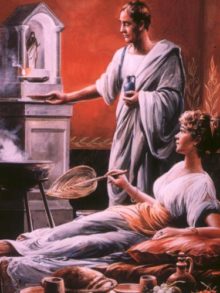 Presumed to be sons of Mercury and Lara, Lares are beneficent and friendly spirits, and deeply venerated by ancient Romans. In every house there was at least one little statue, and through these small statues, the Lare was presumed to take part in all that happened inside the house. Often a statue was put on the table during the meals, and other small statues were often placed in the higher places of the house, far from the floor, or even on the roof.
Presumed to be sons of Mercury and Lara, Lares are beneficent and friendly spirits, and deeply venerated by ancient Romans. In every house there was at least one little statue, and through these small statues, the Lare was presumed to take part in all that happened inside the house. Often a statue was put on the table during the meals, and other small statues were often placed in the higher places of the house, far from the floor, or even on the roof.
The Lares were worshiped in small sanctuaries or shrines, called Lararium, which could be found in every Roman house. They were placed in the atrium (the main room) or in the peristylium (a small open court) of the house. Here people sacrificed food to the Lares on holidays.
Care and attendance to domestic Lares could include offerings of spelt wheat and grain-garlands, honey cakes and honeycombs, grapes and first fruits, wine and incense. They could be served at any time and not always by intention: as well as the formal offerings that seem to have been their due, any food that fell to the floor during house banquets was theirs. On important occasions, wealthier households may have offered their own Lares a pig.
A household’s lararium, a shrine to the Lares Familiaris, usually stood near the hearth or in a corner of the atrium. A lararium often had the appearance of a cupboard or a niche containing a small statue, a niche painted on a wall, or a small freestanding shrine. Sometimes the Genius of the head of the household, pictured as a bearded or crested snake, or as a man with the fold of his toga covering his head, is depicted with the Lar.
Iconography: Lares are usually depicted as two young men with a watch dog; if depicted in serpentine form, then they may be crowned.
The Lares Compitales, the guardian spirits who protected local neighborhoods were housed in the crossroad shrines which served as a focus for the religious, social and political life of their local, overwhelmingly plebeian communities. Shrines were erected at crossroads. These shrines were usually open in all directions so that the Lares could travel as needed.
More about the Lares Compitales and their festival and feast days can be found here:
- Names: Eleutheria, Ilithyia, Genetyllis
- Origin: Crete
- Favored People: Midwives
- Attribute: Torch
Eileithyia is the ancient goddess of childbirth, midwifery, and birthing pains. Eleithyia’s name translates as “Fluid of Generation,” giving her strong fertile aspects, and she also has a hand in personal fate.
According to myth, Eleithyia was the midwife of the gods and even birthed Eos, the creative force behind all things. When Eleithyia’s hands were closed, birth was delayed. When Eleithyia opened her body, a child arrived effortlessly.
Eileithyia is believed to be a Minoan goddess assimilated into the Greek pantheon as Hera’s daughter. She works very closely with Hera and is Hera’s weapon in her struggle to prevent Zeus’ other wives from giving birth and threatening the sovereignty and status of her own children. Without Eileithyia’s cooperation, labor cannot go well and perhaps cannot occur at all.
Eileithyia was venerated by pregnant women and those in labor to provide safety success and to lessen pain. Although comparatively little attention is paid to her in mythology books, she was actually subject of great popular veneration. She had many shrines and was considered an extremely significant deity.
Iconography: A woman bearing a torch or with hands upraised, as if beckoning. Sometimes there is one Eileithyia, but sometimes she is portrayed as a pair of spirits.
Sacred site: The cave of Eileithyia near Knossis, Crete, is allegedly her birthplace and was an important pilgrimage site. She is associated with caves, in general. Eileithyia was a widely venerated goddess with shrines throughout Greece.
Offerings: Ex-votos (milagros) in the shape of breasts; incense; water
- Names: Befana la Strega, Befana the Witch, Befana la Vecchia, Befana the Crone, Befania
- Attributes: Distaff, spindle, sack of gifts
- Home: Befana lives within chimneys
Befana is a benevolent Italian witch who brings gifts to children on Epiphany Eve (Jan 5). She fills children’s stockings with gifts just like Santa Claus does elsewhere.
Befana may pre-date Christianity and may originally be a goddess of ancestral spirits, forests, and the passage of time. Some identify this wandering nocturnal crone with Hekate.
Other legends describe her as an elderly woman in either ancient Judea or Italy who was too busy cleaning to heed the Magi when they invited her to join them in paying homage to the newborn Christ Child. Befana soon regretted her decision and has spent the past two thousand years trying to catch up with the Magi, leaving gifts for good children along the way.
Manifestation:
Befana manifests as an old lady who flies through the air on a broom or goat. She carries a heavy sack on her back filled with gifts or is a hunchback.
Time:
Befana is most active on the night of Jan 5th, the eave of the Feast of the Epiphany and the Day of the Magi. However, she may be contacted for assistance at other times as well. Befana is invoked in many Italian spells, especially those for good fortune.
Offerings:
Befana travels the world leaving gifts on Epiphany Eve (the night of January 5th). As an old lady can get tired from all that flying around; leave her some gifts to replenish her spirits: espresso, Strega liquore, cookies, Italian pastry.
From: The Encyclopedia of Spirits
- Titles: The Mighty One, Great of Magic, Lady of Terror, Lady of Action, The One Before Whom Evil Flees, Mistress Dread, Lady of Flame, The Scarlet Woman
- Element: Fire
- Color: Red
- Consort: Ptah
- Son: Nefertem
- Origin: Upper Egypt
- Attribute: A two headed snake; Sekhmet holds one head in each hand. Also arrows
- Manifestation: Sekhmet manifests as a woman with a lion’s head or as a lioness.
- Feast Day: Feast of Sekhmet – Egyptian New Year’s Day – Jan 7
Sekmet, lioness goddess, epitomizes the blazing, scorching power of the sun. She is the goddess of war, justice, destruction, and healing. Her name may derive from a root word meaning “to be strong, powerful, mighty, or violent.” Sekhmet is among the fiery manifestations of the Eye of Ra.
She is a fierce guardian goddess of Upper Egypt. Her hot breath created the desert. Sekhmet was associated with plagues and pestilential diseases; illnesses that blew in on the desert winds. Sensational descriptions of Sekhmet tend to emphasize her destructive aspects, but she was also among Egypt’s most significant healing deities and remains an active healer today.
Sekhmet was represented by the searing heat of the mid-day sun (in this aspect she was sometimes called “Nesert“, the flame) and was a terrifying goddess. However, for her friends she could avert plague and cure disease. She was the patron of Physicians, and Healers and her priests became known as skilled doctors. As a result, the fearsome deity sometimes called the “lady of terror” was also known as “lady of life“. Sekhmet was mentioned a number of times in the spells of The Book of the Dead as both a creative and destructive force, but above all, she is the protector of Ma´at (balance or justice) named “The One Who Loves Ma´at and Who Detests Evil“.
Most spirits must be asked before they will openly intervene in someone’s life. (It’s possible that many perform acts of rescue anonymously). Sekhmet appears when invoked. She is also renowned for appearing in dreams and visions in order to perform successful healings even when no one summoned her, at least not consciously. Instead, Sekhmet recognized a need and personally took the initiative.
If Sekhmet heals you without first being asked, offerings are in order. Sometimes this is a one time favor but it may also be her way of extending matronage. If you wish to accept her offer, then create an altar or make some other gesture of acknowledgement.
Acceptable Offerings:
- Beer by itself or blended with pomegranate juice
- Arrows
- Silver medical tools
- Incense
Sekhmet heals all illnesses except those of the eyes. She is associated with blood ailments. She has dominion over the menstrual cycle and women’s reproductive systems. Sekhmet should not be bothered for trifles, but she is an intensely powerful and proactive healer. She is the matron goddess of reiki.
